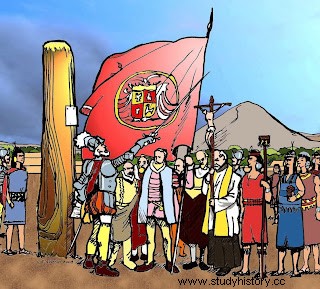 Foundation of Lima by Francisco Pizarro Lima is located in a natural desert, however, when the Spaniards arrived in Lima they found a large valley covered with vegetation. This could have been possible thanks to the construction of irrigation canals during the early intermediate period (200-700 A.D.) and which were perfected at the time of the Wari influence. Large irrigation canals emerged from the Rímac River, which due to their regular size were called rivers. :Guatica or Huatca river, Surco and Maranga rivers. According to Alejandro Reyes Flores and Fernando Flores Zúñiga, the Huatica river entered Lima through the Martinete (today Amazonas jirón), followed by the street of the floats, the neighborhood of Santa Clara, crossed Grau Avenue through Andahuaylas jirón towards Victoria, from there to Lince and San Isidro. After the foundation, the layout was made in blocks on the pre-Hispanic roads that already existed. The model of the castrum or Roman military camp was used for its design.
Foundation of Lima by Francisco Pizarro Lima is located in a natural desert, however, when the Spaniards arrived in Lima they found a large valley covered with vegetation. This could have been possible thanks to the construction of irrigation canals during the early intermediate period (200-700 A.D.) and which were perfected at the time of the Wari influence. Large irrigation canals emerged from the Rímac River, which due to their regular size were called rivers. :Guatica or Huatca river, Surco and Maranga rivers. According to Alejandro Reyes Flores and Fernando Flores Zúñiga, the Huatica river entered Lima through the Martinete (today Amazonas jirón), followed by the street of the floats, the neighborhood of Santa Clara, crossed Grau Avenue through Andahuaylas jirón towards Victoria, from there to Lince and San Isidro. After the foundation, the layout was made in blocks on the pre-Hispanic roads that already existed. The model of the castrum or Roman military camp was used for its design.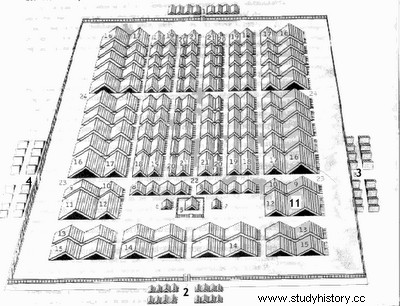 Roman castrum or military camp divided into blocks.
Roman castrum or military camp divided into blocks. 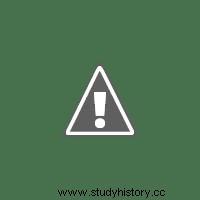 Lima City Map Of that Lima that the Spaniards found, we have little left. According to the reconstructions made by Santiago Agurto, Juan Günther and Fernando Flores Zuñiga, the current historic center of Lima was crossed by canals and paths. On one side was the capac ñam or Inca road that entered the historic center following the jirón quilca. According to Juan Günther:“To the south of the Tianguez, at the intersection of the Inca road with the old wari, current Quilca and Miró Quesada shreds, and current Elguera square, was, according to the Anonymous Portuguese, the Tambo de Lima and what we could call it a communications terminal.” (Günther 1992:41) This was one of several dairy farms that were located at the entrances to the region. The names of some streets have left traces of their existence, Juan Bromley points out some of these:“Tambo de los Caballeros de Balaguer, in the current street of Desamparados; the Tambos de Hinojosa, del Sol and Huánuco, in the neighborhood of San Lázaro; the Tambo Blanco or Mesón Blanco, by the Nazarenas; the Tambo de Belén; the one of the Star, in the street of the Huaquilla; that of the Mermaid, in the street of this name”. (Bromley 2005:124) The pre-Hispanic roads have disappeared, currently only the Quilca, Junín and Miró Quesada jirón are preserved.
Lima City Map Of that Lima that the Spaniards found, we have little left. According to the reconstructions made by Santiago Agurto, Juan Günther and Fernando Flores Zuñiga, the current historic center of Lima was crossed by canals and paths. On one side was the capac ñam or Inca road that entered the historic center following the jirón quilca. According to Juan Günther:“To the south of the Tianguez, at the intersection of the Inca road with the old wari, current Quilca and Miró Quesada shreds, and current Elguera square, was, according to the Anonymous Portuguese, the Tambo de Lima and what we could call it a communications terminal.” (Günther 1992:41) This was one of several dairy farms that were located at the entrances to the region. The names of some streets have left traces of their existence, Juan Bromley points out some of these:“Tambo de los Caballeros de Balaguer, in the current street of Desamparados; the Tambos de Hinojosa, del Sol and Huánuco, in the neighborhood of San Lázaro; the Tambo Blanco or Mesón Blanco, by the Nazarenas; the Tambo de Belén; the one of the Star, in the street of the Huaquilla; that of the Mermaid, in the street of this name”. (Bromley 2005:124) The pre-Hispanic roads have disappeared, currently only the Quilca, Junín and Miró Quesada jirón are preserved. 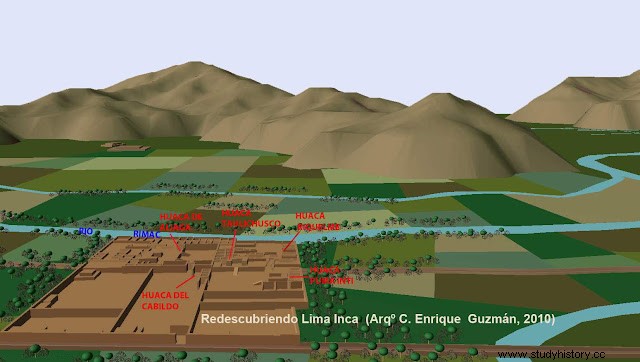
The jirón de la Unión did not exist, instead there was a road that linked the corner of the Jirón Quilca and Belén (block 2 of Jirón de la Unión) with the main square (today the main square). Pizarro disappeared this road when making the grid for the streets. Despite the new urban order, some streets preserved in their names the existence of pre-Hispanic constructions, it is the case of the streets:Huaquilla (block 10 of Jirón Ayacucho) that took its name of a small huaca that was demolished in the second half of the 17th century. Panteoncito (block 3 of the Rufino Torrico jirón) Juan Bromley believes that a small huaca of Indians could have existed on this street. Huaquilla trail (block 1 of the Cangallo jirón) where the perforated stone is located, which is considered a pre-Hispanic stone. María Rostworowski does not believe that this stone is related to the huaca of Plaza Santa Ana (today Plaza Italia). Tambo del Sol (jirón Chalaco in the Rímac) that takes its name from an inn that welcomed travelers who came along the way Inca from northern Peru. The existence of a pre-Hispanic tambo is not ruled out. Jirón Trujillo (Rímac district) takes its name from being built on the old Inca road that went to Trujillo. This road continued along the Rímac and came out towards what is now Túpac Amaru Avenue.
THE PLAZA MAYOR
The pre-Hispanic plaza was slightly triangular in shape. On this the Plaza Mayor was created. In this place the Taulichusco Palace (current Government Palace) was located, on one side a small huaca called by Emilio Hart-Terré, Puma Inti (the Cathedral of Lima was built on this) and on the other end a llama corral that was property of Taulichusco (land today occupied by the municipality of Lima). Regarding the Taulichusco palace, Juan Günther notes:“The palace of the curaca formed a single unit with the Jerónimo de Aliaga site, which was accessed by a ramp, parallel to the current Palacio street, which over time has become the staircase that gives access to the presidential offices from the aforementioned street. Behind the Palace, as already mentioned, was the intake of the oldest artificial river in the valley and the orchard from where the irrigation of the Huatica River was also controlled.” (Günther 1991:42) The location of the main square was not changed, as this place is a strategic site for the control of the irrigation canals and the Inca roads. In the first block of the jirón de la Unión (palace street) there was a small huaca, on which the Aliaga house was built. The Aliaga house is the oldest in the city of Lima. María Rostworowski believes that this huaca was attached to the Taulichusco palace.
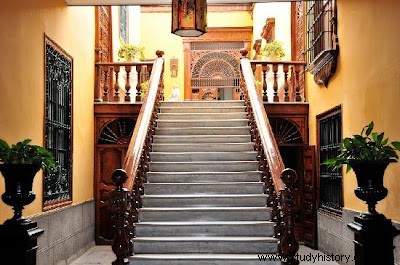 Casa Aliaga, the oldest house in Lima is built on a pre-Hispanic huaca
Casa Aliaga, the oldest house in Lima is built on a pre-Hispanic huaca THE OLDEST STREET IN LIMA
The Quilca jirón is the oldest street in Lima that preserves its pre-Hispanic layout, as it is built on the Inca road that divided the city from east to west and continued towards the current Rímac district. All other routes disappeared under the European grid.
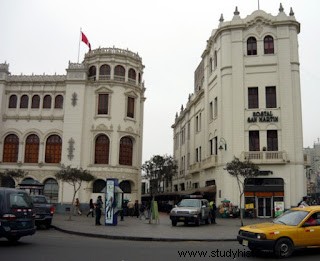 At first glance a pedestrian passageway, in pre-Hispanic times it was part of the great Inca trail . Jirón Quilca seen from the Plaza San Martín
At first glance a pedestrian passageway, in pre-Hispanic times it was part of the great Inca trail . Jirón Quilca seen from the Plaza San Martín On this pre-Hispanic road, potters street (block 3) was located, where the indigenous artisans who made utilitarian ceramics and fish sellers lived. Other pre-Hispanic roads that have been preserved are Jirón Junín, Rufino Torrico and Miró Quesada.
CITY OF HUACAS
The most important huaca in the area was located in what is now Plaza Italia or Plaza Santa Ana. According to María Rostworowski, this is why this plaza maintains the trapezoidal shape of the Inca plazas. This place was very important for the indigenous population and that is why the Santa Ana Indian Hospital was founded there. Waldemar Espinoza and Juan Günther believe that the oracle of Lima was in this place, following information from the chronicler Cristóbal de Albornoz. “Rimac , guaca of the Indians of Lima who called themselves ychmas, where the city of the Kings is populated, was a round stone. It is in a plain where Gerónimo Silva has the gueta”. (Günther 1991:41)
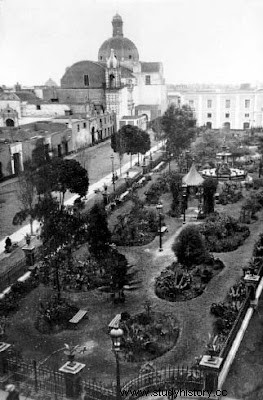 Plaza Santa Ana or Italia, in this place the most important huaca of Lima was located
Plaza Santa Ana or Italia, in this place the most important huaca of Lima was located 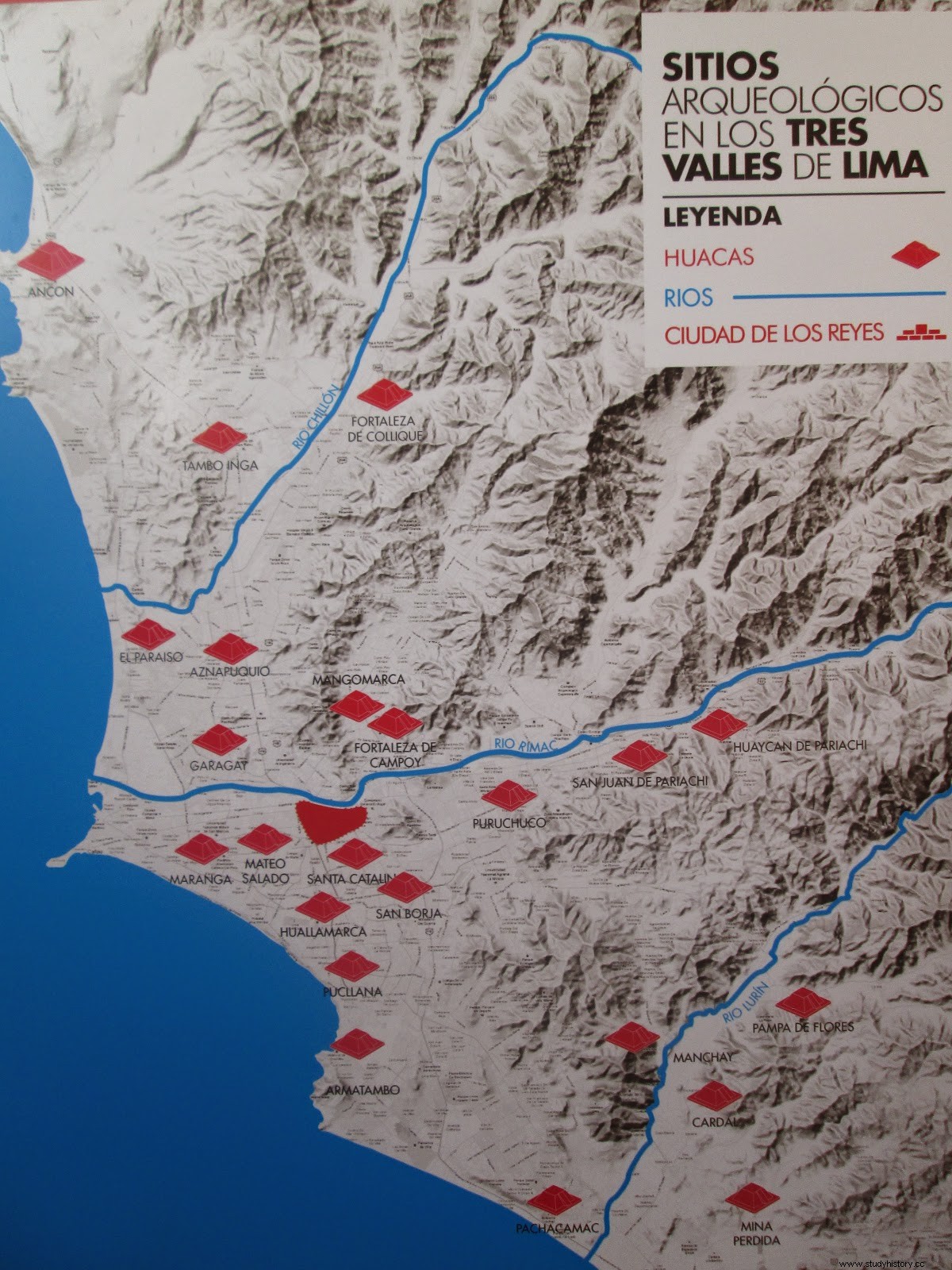 Archaeological sites of pre-Hispanic Lima WHO WAS TAULICHUSCO?
Archaeological sites of pre-Hispanic Lima WHO WAS TAULICHUSCO? The curacazgos of Lima were conquered by the Incas. The government of the valley was in the hands of Taulichusco, a curaca yana of Mama Vilo, secondary woman of Huayna Capac. Francisco Pizarro established his residence in the palace of Taulichusco and stripped him of his power. He lived some years. His sons Francisco and Gonzalo were heirs to nothing. Very little is known about Taulichusco, just a few documents found by Lohmann Villena tell us about this curaca and his descendants. In recent decades the figure of this yana curaca has been rescued forgetfulness. During the administration of Mayor Alfonso Barrantes, a monument to Taulichusco was erected in the Santa Rosa passage, next to the municipal building. Despite knowing little about him, since 2006, a group of congressmen and neo-indigenist organizations have organized a tribute called the "indigenous foundation of Lima". This event that speaks of a historical character, could be part of a political interpretation. Talking about Taulichusco as the last curaca or lord of Lima creates a somewhat false image of our past. Let us remember María Rostworowski and Waldemar Espinoza who have emphasized that he was a yana curaca. The yana curacas were not always native to the place where they ruled. They were not free either, they were servants of the Inca or of the panacas. That is to say, they were not lords, the land they governed did not belong to them, nor did it belong to them. Talking about Taulichusco as an indigenous lord is very relative, we are rather dealing with a yana, a servant who took care of the land, cattle and production. of the Inca In addition, there are serious doubts about Taulichusco as the last curaca of Lima, and Raúl Porras Barrenechea doubted that this curaca had governed due to his advanced age. Some want to use the image of Taulichusco to recreate an indigenous identity of Lima from the present, however, This historical manipulation has very fragile foundations. If not, just remember the famous controversy during the administration of Mayor Luis Castañeda when the Pizarro monument was moved to the Parque de la Muralla. For this reason, in the face of any present ideological manipulation of our past, it is better to resort to historical research.
I forgot, happy day to my beloved city, to the old and new people of Lima. To those who always knew her and to those who just discovered her with curious eyes.
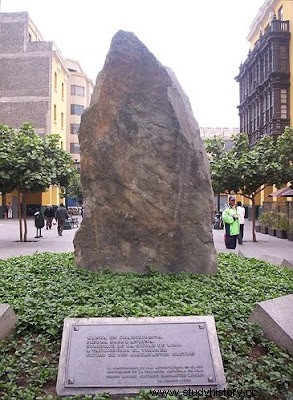 Monument to Taulichusco, last curaca of Lima
Monument to Taulichusco, last curaca of Lima 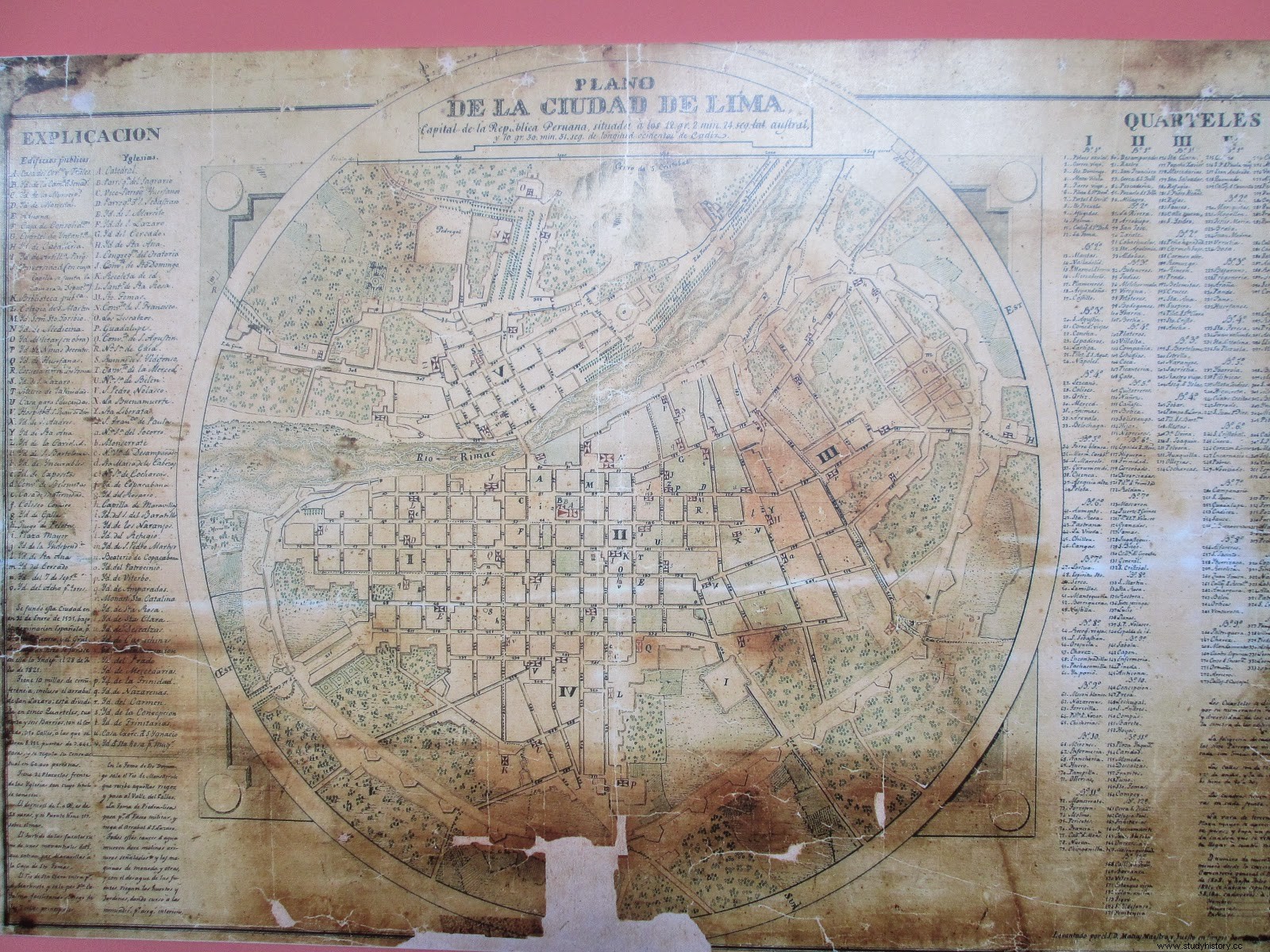 MAP OF COLONIAL LIMA BIBLIOGRAPHY
MAP OF COLONIAL LIMA BIBLIOGRAPHY - Commemorative album of the IV centenary of the foundation of Lima. Lima:Imp. C. Ruiz, 1935
- AGURTO, Santiago. Prehispanic Lima. Lima:Municipality of Lima – FINANPRO. 1984
- BROMLEY, John. The old streets of Lima. Lima:Municipality of Lima. 2005
- GÜNTHER DOERING, Juan and Guillermo LOHMANN VILLENA. Lime. Madrid:Mapfre. 1992
- LOHMANN VILLENA, Guillermo. "The testament of the curaca of Lima don Gonzalo Taulichusco (1562)". Magazine of the General Archive of the Nation, 7:267-275. 1984
- PORAS BARRENECHEA, Raul. “The Indian root of Lima”. http://sisbib.unmsm.edu.pe/bibvirtual/libros/linguistica/legado_quechua/la_raiz.htm
- ROSTWOROWSKI, Maria. "Lima before Lima". (Interview)http://www.librosperuanos.com/autores/maria-rostworowski2.html
- Fernando Flores Zúñiga and Alejandro Reyes. Forum on the Huatica River.
